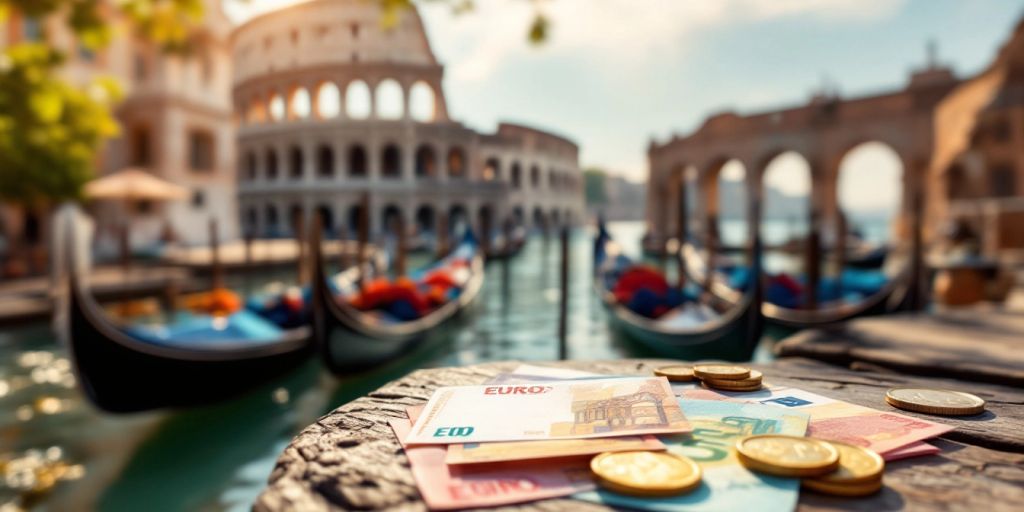When planning a trip to Italy, understanding the local currency and payment methods is crucial for a smooth experience. The country uses the euro (€), which is not just the official currency but also a vital part of daily transactions. Knowing how to manage your money effectively can help you enjoy your vacation without any financial hiccups. This article will guide you through everything you need to know about using currency while traveling in Italy, including best practices for exchanging money, using cards, and avoiding common pitfalls. Plus, don’t forget to check out TripCorner for personalized travel planning to make your trip unforgettable!
Key Takeaways
- The euro (€) is the only currency accepted in Italy, so avoid bringing US dollars.
- Using credit and debit cards is common; inform your bank before traveling to avoid issues.
- ATMs are widely available, but choose bank-affiliated ones to minimize fees.
- Avoid exchanging currency at airports and hotels due to high fees and poor rates.
- Carrying a small amount of cash is wise for small purchases, but most places accept cards.
Understanding the Currency in Italy

When traveling to Italy, it’s essential to know that the official currency is the euro. This currency is used throughout the country, including all its beautiful islands. The euro is represented by the symbol € and has a currency code of EUR.
Euro Banknotes and Coins
You will find euro banknotes in various denominations: 5, 10, 20, 50, 100, 200, and 500. However, the 200 and 500 euro notes are rarely used. The coins come in 1 and 2 euro denominations, as well as 1, 2, 5, 10, 20, and 50 cents. Here’s a quick overview:
| Denomination | Type |
|---|---|
| 5 | Banknote |
| 10 | Banknote |
| 20 | Banknote |
| 50 | Banknote |
| 100 | Banknote |
| 200 | Banknote |
| 500 | Banknote |
| 1 | Coin |
| 2 | Coin |
| 1 cent | Coin |
| 2 cents | Coin |
| 5 cents | Coin |
| 10 cents | Coin |
| 20 cents | Coin |
| 50 cents | Coin |
Currency Code and Symbol
The euro is recognized globally, and its currency code is EUR. This makes it easy to identify when exchanging money or making purchases. Always look for the € symbol when checking prices in Italy.
History of the Euro in Italy
Italy adopted the euro in 2002, replacing the old lira. This change was part of a broader move to unify European currencies, making travel and trade easier across the continent. The euro has since become a strong and stable currency, widely accepted in many countries.
Understanding the currency is crucial for a smooth trip. Familiarize yourself with the euro before you go to avoid confusion.
For more tips and services to enhance your travel experience, check out [Tripcorner](https://tripcorner.com).
Using Credit and Debit Cards in Italy
Chip-and-PIN System
In Italy, you can easily use your credit and debit cards. Businesses are required by law to accept electronic payments, including credit cards. Most places use a chip-and-PIN system, so make sure you know your PIN. For purchases under about €20, you might not need to enter your PIN, but for larger amounts, you will.
Informing Your Bank
Before you travel, it’s smart to inform your bank about your trip. This way, your cards won’t get blocked for suspicious activity. Here are some tips:
- Call your bank to notify them of your travel dates.
- Ask about any international transaction fees.
- Consider getting a card with no foreign transaction fees.
Dynamic Currency Conversion
Be cautious with Dynamic Currency Conversion (DCC). Some ATMs and card readers may offer to charge you in your home currency instead of euros. Always choose to pay in euros to avoid unfavorable exchange rates. If you see an option to lock in a conversion rate, opt to proceed without conversion.
Remember, while credit cards are widely accepted, it’s still a good idea to carry some cash for smaller shops and markets. Having a mix of payment options can make your trip smoother!
Best Practices for Exchanging Currency

When traveling in Italy, knowing how to exchange your money wisely can save you a lot. Here are some best practices to keep in mind:
Avoiding Airport and Hotel Exchanges
Avoid exchanging currency at airports and hotels. These places often charge high fees and offer poor exchange rates. Instead, look for local banks or ATMs once you arrive in Italy. You’ll get a better deal and save money in the long run.
Using ATMs Wisely
Using ATMs is one of the best ways to get euros. Here’s how to do it:
- Find a bank-affiliated ATM: Look for ATMs that are part of a bank network. They usually have lower fees.
- Check your bank’s foreign exchange fees: Make sure you know what your bank charges for international withdrawals. This can help you avoid unexpected costs.
- Withdraw larger amounts: To minimize fees, consider withdrawing larger sums of cash at once instead of multiple small withdrawals.
Choosing Local Currency
When making purchases, always choose to pay in euros. Dynamic Currency Conversion (DCC) can seem convenient, but it often comes with hidden fees. Paying in local currency ensures you get the best exchange rate.
Remember, it’s best to exchange your dollars before you leave or use an ATM in Italy. This way, you avoid losing money on unfavorable rates.
By following these tips, you can make your money go further while enjoying your trip. For more travel tips and services, check out [tripcorner](https://tripcorner.com).
Managing Cash While Traveling

How Much Cash to Carry
When traveling in Italy, it’s smart to carry just enough cash for daily expenses. Here are some tips:
- Bring around €100-200 for emergencies.
- Use ATMs to withdraw cash as needed.
- Avoid carrying large amounts to reduce risk.
Safety Tips for Handling Cash
Keeping your cash safe is crucial. Here are some strategies:
- Divide your money: Keep some cash in different places.
- Use an anti-theft bag to store your cash securely.
- Carry small bills for easier transactions.
Using Contactless Payment Options
Contactless payments are becoming more common in Italy. Consider these options:
- Use mobile payment apps like Apple Pay or Google Wallet.
- Prepaid travel cards can be a safe alternative.
- Always have a backup credit card in case of emergencies.
Remember, having a plan for your cash can help you enjoy your trip without stress. Keep your cash organized and secure, and you’ll be ready for anything Italy throws your way! For more tips and services, check out Tripcorner.
Tips for Using ATMs in Italy
Finding Reliable ATMs
When you need to withdraw cash in Italy, look for one word: bancomat. These ATMs are usually attached to banks and offer better exchange rates without extra fees. Avoid independent ATMs, especially those from Euronet, as they often charge high fees.
ATM Withdrawal Limits
Most bank-affiliated ATMs allow you to withdraw up to €250 per day. This limit helps you manage your cash flow while traveling. Always check your bank’s policies before you go to avoid surprises.
Avoiding High Fees
To keep your costs down, always choose to be charged in euros rather than your home currency. This way, you’ll get your bank’s exchange rate instead of a potentially unfavorable rate from the ATM.
Remember, using a bank-affiliated ATM is the best way to avoid unnecessary fees.
Summary of ATM Tips
- Use bancomat ATMs for better rates.
- Withdraw cash in euros to avoid extra charges.
- Check your bank’s withdrawal limits before traveling.
By following these tips, you can make your cash withdrawals in Italy smooth and cost-effective. For more travel tips and assistance, check out Tripcorner.
Alternative Payment Methods

Using Mobile Payment Apps
Mobile payment apps are becoming more popular in Italy. PayPal is the most widely used app, but it’s mainly for peer-to-peer payments. Other apps like Google Pay and Apple Pay are also accepted in many places, especially in tourist areas. Just make sure they are linked to a Visa or Mastercard.
Prepaid Travel Money Cards
Prepaid travel money cards can be a safe option. You load them with money before your trip, and they work like debit cards. This way, you can avoid carrying too much cash. Just remember to check for any fees associated with using them abroad.
Online Money Transfers
Online money transfers can be useful for paying for services in advance. Some tour companies accept payments through platforms like PayPal. This can help you avoid carrying large amounts of cash. However, always check if there are any extra fees involved.
Tip: Always have a backup payment method. If one option fails, you’ll have another ready to go.
Summary of Payment Methods
| Payment Method | Acceptance Rate | Notes |
|---|---|---|
| Mobile Payment Apps | Moderate | Mainly in tourist areas |
| Prepaid Travel Money Cards | High | Check for fees |
| Online Money Transfers | Low | Useful for advance payments |
In Italy, while cash is still king, these alternative payment methods can make your trip easier. Just remember to keep your options open and check with Tripcorner for more tips on managing your money while traveling!
Common Currency Mistakes to Avoid
Bringing US Dollars
Many travelers think they can use US Dollars in Italy, but this can lead to higher costs. Small shops may charge you up to 20% more if you pay in dollars instead of euros. Stick to the local currency to avoid unnecessary fees.
Exchanging Large Amounts in Advance
It might seem smart to exchange a lot of money before your trip, but this can backfire. You may end up with leftover euros that you can’t easily convert back. Instead, exchange only what you need for the first few days.
Relying Solely on Cash
While cash is important, relying only on it can be risky. Many places accept credit and debit cards, which can be safer and more convenient. Always have a mix of cash and cards to cover all your bases.
Remember, managing your money wisely can make your trip smoother and more enjoyable.
Summary of Common Mistakes
| Mistake | Consequence |
|---|---|
| Using US Dollars | Higher costs |
| Exchanging too much in advance | Leftover currency |
| Relying only on cash | Risk of loss or theft |
By avoiding these common mistakes, you can enjoy your trip without worrying about money. For more tips and services, check out Tripcorner.
When planning your travels, it’s easy to make mistakes with currency. To avoid common pitfalls, like not checking exchange rates or forgetting to notify your bank, take a moment to prepare. For more tips and to plan your perfect trip, visit our website today!
Final Thoughts on Currency in Italy
When traveling in Italy, using euros is the best choice. The euro is the official currency, and most places accept credit and debit cards, making it easy to pay for things. Avoid bringing US dollars, as they are not widely accepted and can cause problems. Instead, consider getting a Wise travel card to save on fees and get good exchange rates. Remember to inform your bank about your trip to avoid any issues with your cards. With a little planning, you can enjoy your Italian adventure without worrying about money!




